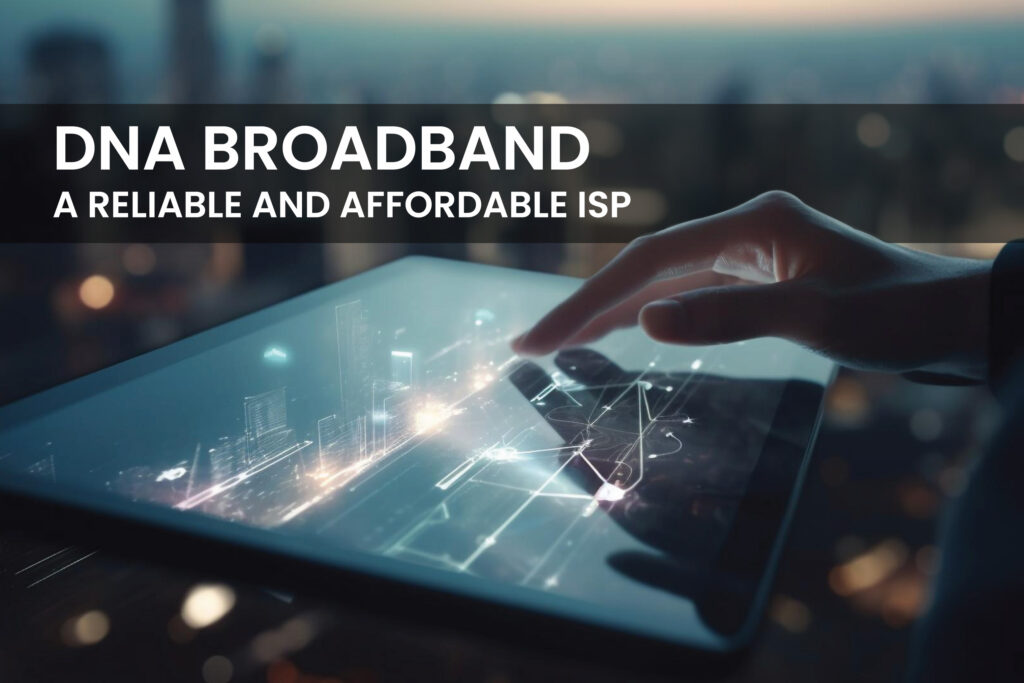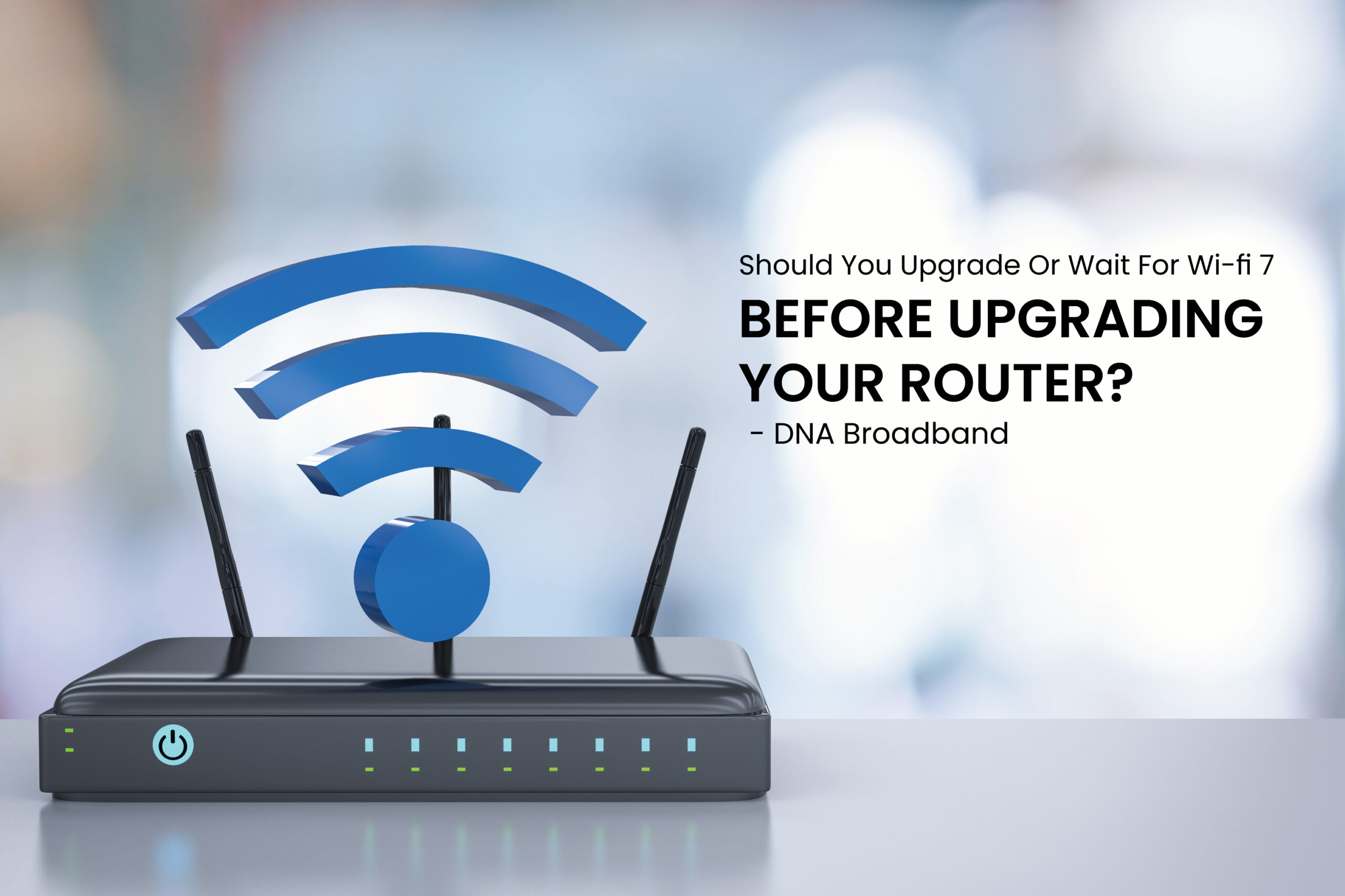Should You Upgrade Or Wait For Wi-Fi 7 Before Upgrading Your Router? – DNA Broadband
In today’s fast-paced digital world, having a reliable and high-speed internet connection is crucial. With the advent of new technologies and standards, the question on everyone’s mind is whether to upgrade their current Wi-Fi router or wait for the next big thing – Wi-Fi 7. This decision is not to be taken lightly, as it involves weighing the benefits of upgrading now against the potential advancements of future technologies.
In this blog, we’ll delve into the intricacies of Wi-Fi 7, the current state of Wi-Fi technology, and help you make an informed decision about upgrading your router.
Understanding Wi-Fi 7: What’s the Hype About?
Wi-Fi 7 is the next generation of Wi-Fi, and it’s generating a lot of hype for good reason. It’s expected to be significantly faster and more efficient than Wi-Fi 6, with peak speeds of up to 46 Gbps. That’s up to 5.8 times faster than Wi-Fi 6!
Wi-Fi 7 will also have lower latency, which means it will be more responsive for applications like online gaming and video conferencing. It will also be able to support more devices simultaneously, making it ideal for homes and businesses with a lot of connected devices.
Here are some of the key benefits of Wi-Fi 7:
- Faster speeds: Wi-Fi 7 is expected to be up to 5.8 times faster than Wi-Fi 6, with peak speeds of up to 46 Gbps. This will make it possible to download and stream large files quickly, and to play online games with low latency.
- Lower latency: Wi-Fi 7 will have lower latency than Wi-Fi 6, which means it will be more responsive for applications like online gaming and video conferencing. This is because Wi-Fi 7 uses a new technology called Multi-Link Operation, which allows devices to use multiple channels simultaneously to transmit data.
- More efficient: Wi-Fi 7 will be more efficient than Wi-Fi 6, which means it will be able to support more devices simultaneously without sacrificing performance. This is because Wi-Fi 7 uses a new technology called Operation in the 6 GHz Band, which provides more spectrum for Wi-Fi devices to use.
Wi-Fi 7 is still under development, but it is expected to be released in 2023. Wi-Fi 7 devices are expected to start appearing in the market in 2024.
Here are some of the potential applications of Wi-Fi 7:
- Streaming and gaming: Wi-Fi 7 will make it possible to stream high-definition video and play online games with low latency. This will make for a more immersive and enjoyable experience.
- Virtual reality and augmented reality: Wi-Fi 7 will support virtual reality and augmented reality applications, which require high bandwidth and low latency.
- Smart homes and businesses: Wi-Fi 7 will be able to support a large number of smart devices simultaneously, making it ideal for smart homes and businesses.
- Industrial applications: Wi-Fi 7 will be used for industrial applications such as machine-to-machine communication and autonomous vehicles.
Overall, Wi-Fi 7 is a significant upgrade over Wi-Fi 6. It is expected to be faster, more efficient, and have lower latency. Wi-Fi 7 will enable new applications and make existing applications more enjoyable.

The Current State of Wi-Fi Technology: Wi-Fi 6
Wi-Fi 6, also known as 802.11ax, is the latest generation of Wi-Fi technology, released in 2020. It is a significant upgrade over its predecessor, Wi-Fi 5 (802.11ac), offering faster speeds, improved performance in crowded environments, and better battery life for devices.
Wi-Fi 6 achieves its performance gains through a number of new features, including:
- Orthogonal frequency-division multiple access (OFDMA): OFDMA allows multiple devices to share the same channel simultaneously, which can significantly improve performance in crowded environments.
- Multi-user MIMO (MU-MIMO): MU-MIMO allows an access point to communicate with multiple devices simultaneously, which can also improve performance in crowded environments.
- 1024-QAM modulation: 1024-QAM modulation allows for more data to be transmitted over the same channel, which can increase overall speeds.
- Target wake time (TWT): TWT allows devices to negotiate when they will wake up to receive data, which can help to save battery life.
In real-world tests, Wi-Fi 6 has been shown to offer up to 4 times faster speeds than Wi-Fi 5, and up to 75% lower latency. It is also better able to handle multiple devices simultaneously, making it ideal for crowded environments such as offices, airports, and sporting events.
Wi-Fi 6 is still a relatively new technology, but it is quickly becoming more widely adopted. Many new smartphones, laptops, and routers now support Wi-Fi 6, and the number of supported devices is expected to grow rapidly in the coming years.
Factors to Consider Before Upgrading
- Current Internet Speed: If your internet plan doesn’t deliver speeds that utilize the full potential of Wi-Fi 6, upgrading to Wi-Fi 7 might not provide significant benefits. Assess your internet speed and determine if your current Wi-Fi setup meets your requirements.
- Device Compatibility: Check if the devices you use regularly, such as smartphones, laptops, and smart home appliances, support Wi-Fi 6. If not, upgrading to a Wi-Fi 6 or Wi-Fi 7 router might not make sense until your devices catch up with the latest technology.
- Budget: Consider your budget. While Wi-Fi 7 routers will undoubtedly offer cutting-edge technology, they might come at a premium price initially. Wi-Fi 6 routers, on the other hand, might see a price drop as Wi-Fi 7 becomes more prevalent.
- Future-Proofing: If you are the type of consumer who likes to future-proof their technology, waiting for Wi-Fi 7 might be a good choice. Wi-Fi 7 is expected to be more efficient and secure, making it a viable option for long-term use.
- Security Concerns: Cybersecurity is a significant consideration. Wi-Fi 7 is expected to bring enhanced security features, which might be crucial if you prioritize protecting your home network from potential threats.

DNA Broadband: A Reliable and Affordable ISP
DNA Broadband is a leading Internet service provider (ISP) in India, offering high-speed broadband and WiFi services to homes and businesses in Pune, Mumbai, and Palghar. With over 10 years of experience in the industry, DNA Broadband is committed to providing its customers with the best possible internet experience.
Here are some of the benefits of choosing DNA Broadband as your ISP:
- High-speed broadband and WiFi services
- Unlimited data usage on all plans
- Variety of value-added services
- Reliable and affordable services
- Strong customer support team
- Variety of discounts and promotions
If you are looking for a reliable and affordable ISP in Pune, Mumbai, or Palghar, then DNA Broadband is the perfect choice for you.
To learn more about DNA Broadband’s plans and services, visit the website or call the customer support team today.

